
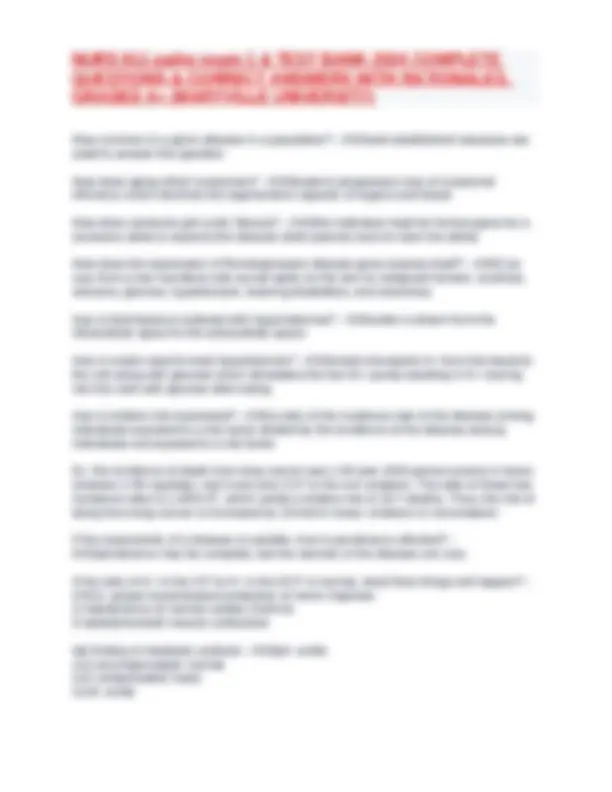

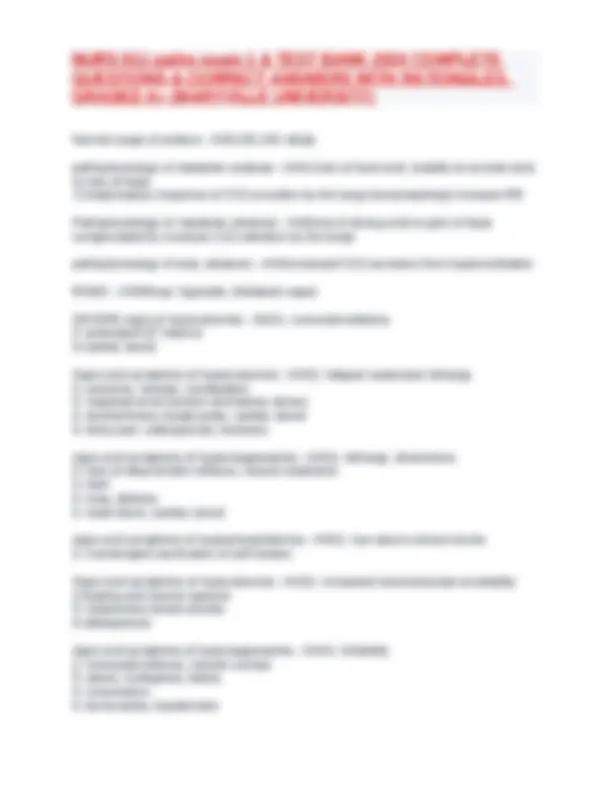
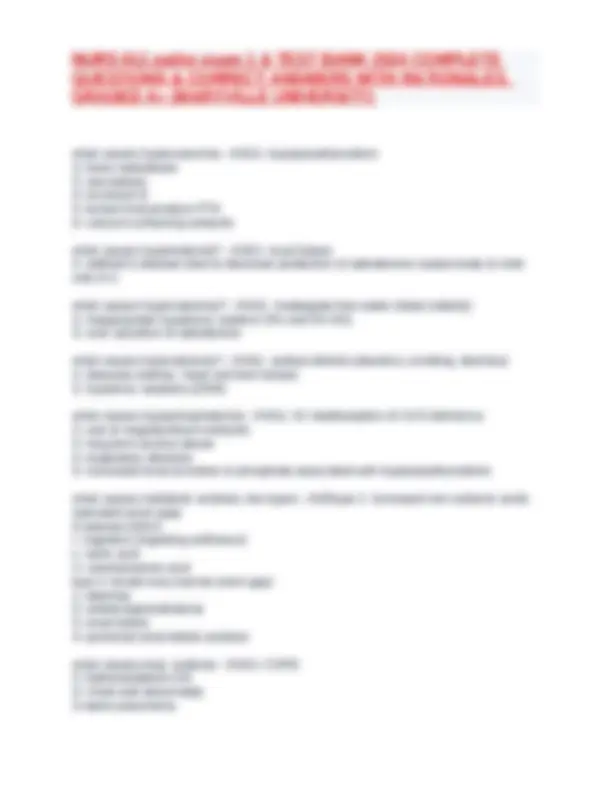


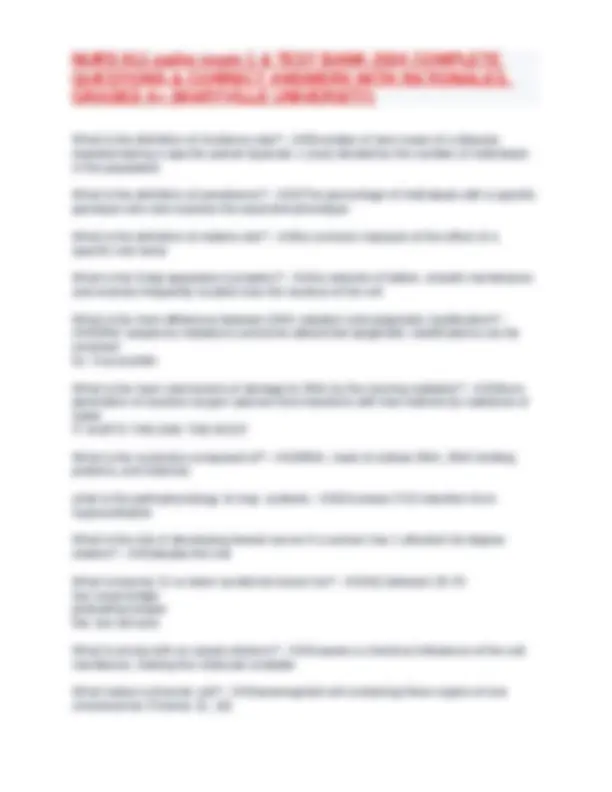
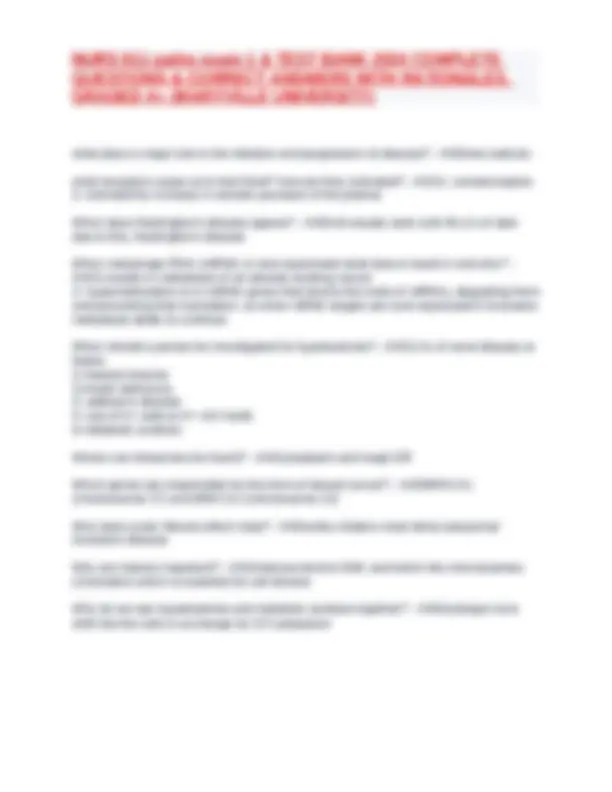


Study with the several resources on Docsity

Earn points by helping other students or get them with a premium plan


Prepare for your exams
Study with the several resources on Docsity

Earn points to download
Earn points by helping other students or get them with a premium plan
Community
Ask the community for help and clear up your study doubts
Discover the best universities in your country according to Docsity users
Free resources
Download our free guides on studying techniques, anxiety management strategies, and thesis advice from Docsity tutors
NURS 611 patho exam 1 & TEST BANK 2024 COMPLETE QUESTIONS & CORRECT ANSWERS WITH RATIONALES. GRADED A+ (MARYVILLE UNIVERSITY).docx
Typology: Exams
1 / 14

This page cannot be seen from the preview
Don't miss anything!









Apoptosis - ANSA programmed cell death that is regulated or programmed. Cellular self-destruction for elimination or unwanted cell populations Calcium and phosphorus have what kind of relationship> and is influenced by which 3 things? - ANS1- reciprocal 2- PTH, calcitonin, and vit D causes of hypermagnesemia - ANS1- renal insufficiency or failure (most common) 2- excessive intake of mag antacids 3- adrenal insufficiency causes of hyperphosphatemia - ANS1- acute or chronic renal failure 2-treatment of metastatic tumors with chemo that releases large amounts of phosphate 3- long term use of laxatives/enemas 4- hypoparathyroidism causes of hypocalcemia? - ANS1- Hypoalbuminemia 2- massive blood administration 3- Decreases in PTH and Vit D levels 4- malnutrition 5-alkalosis 6-elevated calcitonin level 7-pancreatitis 8- inadequate GI absorption causes of hypomagnesemia - ANS1- malnutrition 2-alcoholism 3-malabsorption syndrome 4- urinary losses Causes of metabolic alkalosis - ANS1- vomiting 2-NG suctioning 3-Hypokalemia 4-diuretic therapy excess HCO3 intake
causes of resp. alkalosis - ANS1- hyperventilation 2- stroke, septicemia, meningitis, encephalitis, brain injury 3- mechanical hyperventilation cellular metabolism- what molecule gives us energy? - ANSATP functions as the energy-transferring molecule Cystic fibrosis is caused by what type of gene? - ANSautosomal recessive During ischemia, what effect does the loss of ATP have on the cells? - ANSa reduction of ATP levels (ATP needs oxygen) that causes the Na+/K+ pump and Na+/Ca exchange to fail, leading to intracellular accumulation of Sodium and calcium and diffusion of K+ out of the cell. Sodium and water can enter cell freely causing cellular swelling Example of beneficial physiologic hypertrophy? - ANShypertrophy of myocardial cells from endurance training example of compensatory hyperplasia? - ANSregeneration of the liver example of hormonal hyperplasia - ANSenlargement of the uterus during pregnancy example of metaplasia - ANSnormal columnar ciliated epithelial cells of the bronchial lining being replaced by squamous cells. can be reversed if irritant stopped example of pathologic hypertrophy - ANScardiomegaly in a hypertensive patient example of pathological hyperplasia - ANSendometrial tissue explain how fluid moves from the intravascular space into the interstitial space. what is it influenced by>? - ANSthrough the arterial end of capillaries and the capillary hydrostatic pressure being higher than the capillary oncotic pressure. It is influenced by the cardiac system (think about the heart getting fluids/nutrients where they need to go) Explain RAAS - ANS1- circulating blood volume/pressure is reduced felt by the kidneys 2- renin is released in response to the sympathetic nerve stimulation and decreased perfusion of the renal vasculature. Angiotension I is converted into Angiotension II. 3- aldosterone is pumped out by the adrenal glans (main hormone released to increase perfusion). aldosterone increased sodium and therefore an increase in storage of water and increases BP
Lab finding of resp acidosis - ANSph- low CO2- high HCO3- normal (uncompensated) HCO3- high (compensated) lab findings of metabolic alkalosis - ANSph basic CO2 uncompensated- normal CO2 compensated- acidic HCO2- basic lab findings of respalk. - ANSph- high co2-low hco3 uncompensated- normal hco3 compensated- low Main component of a cell - ANSnucleus name 3 natriuretic peptides and what they produce by/ associated with - ANS1- Artialnatriuetric peptide (ANP) produced by the myocardia atria 2- brain natriuretic peptide (BNP) produced by the myocardia ventricles 3- Urodilation within the kidney Name 3 populations vulnerable to fluid volume deficit - ANS1- infants: 75-80% total body water 2- obese: fat is water repelling (BMI >30) 3-elderly: thirst sensation is diminished Necrosis - ANSRapid loss of the plasma membrane structure, organelle swelling, mitochondria dysfunction normal CO2 range - ANS35- normal HCO3 range - ANS22- normal range of calcium - ANS8.5-10. normal range of magnesium - ANS1.5- normal range of pH level - ANS7.35-7. normal range of potassium? - ANS3.5-5 mEq/L
Normal range of sodium - ANS135-145 mEq/L pathophysiology of metabolic acidosis - ANS-Gain of fixed acid ,inability to excrete acid, or loss of base. -Compensatory response of CO2 excretion by the lungs (kussmaulresp) increase RR Pathophysiology of metabolic alkalosis - ANSloss of strong acid or gain of base compensated by increase CO2 retention by the lungs pathophysiology of resp. alkalosis - ANSincreased CO2 excretion from hyperventilation ROME - ANSResp. Opposite, Metabolic equal SEVERE signs of hypocalcemia - ANS1- convulsions/tetany 2- prolonged QT interval 3-cardiac arrest Signs and symptoms of hypercalcemia - ANS1- fatigue/ weakness/ lethargy 2- anorexia, nausea, constipation 3- impaired renal function and kidney stones 4- dysrhythmias, bradycardia, cardiac arrest 5- bone pain. osteoporosis, fractures signs and symptoms of hypermagnesemia - ANS1- lethargy, drowsiness 2- loss of deep tendon reflexes, muscle weakness 3- N&V 4- resp. distress 5- heart block, cardiac arrest signs and symptoms of hyperphosphatemia - ANS1- low serum calcium levels 2- if prolonged-calcification of soft tissues Signs and symptoms of hypocalcemia - ANS1- increased neuromuscular excitability 2-tingling and muscle spasms 3- hyperactive bowel sounds 4-osteoporosis signs and symptoms of hypomagnesemia - ANS1- irritability 2- increased reflexes, muscle cramps 3- ataxis, nystagmus, tetany 4- convulsions 5- tachycardia, hypotension
what are the 5 major diseases that are affected by reactive oxygen species and are known to play a role in initiation and progression? - ANShyperlipidemia, diabetes m., hypertension, CHF, and ischemic heart disease What are the 8 signs and symptoms of dehydration - ANS1-headache 2-thirst 3-dry skin 4-dry mucous membranes 5- elevated temp 6-weight loss (except with edema) 7- decreased/ concentrated urine 8- skin turgor normal or decreased (not great ex) look at tongue What are the causes of hypokalemia - ANS1-hyperaldosterone 2- hypernatremia 3- fluid volume excess What are the clinical manifestations of hyponatremia - ANS1-headache 2-lethargy 3-confusion 4-seizures (from cerebral edema) 5-coma (from cerebral edema) What are the clinical manifestations of severe hypernatremia (4 C's) - ANSconfusion, convulsion, cerebral hemorrhage, and coma What are the major characteristics of type 1 DM? - ANS1- T-cell infiltration of the pancreas 2-destruction of the insulin-producing beta cells 3-auto-antibodies are formed against pancreatic cells what are the signs and symptoms of hypokalemia? - ANS1- cardiac- flat t-waves, AV block, bradycardia 2- paralytic ileus (N&V) What can accumulate intracellularly caused by stresses form metabolic dearangements? - ANScarbs, proteins, and lipids What can epigenetic modification cause individuals with the same DNA (twins) - ANShave different disease profiles Ex: the occurrence of asthma in only one pair of the identical twins
what causes hypercalcemia - ANS1- hyperparathyroidism 2- bone metastases 3- sarcoidosis 4- excessvit D 5- tumors that produce PTH 6- calcium containing antacids what causes hyperkalemia? - ANS1- renal failure 2- addison's disease (due to decrease production of aldosterone causes body to hold onto K+) what causes hypernatremia? - ANS1- inadequate free water intake (elderly) 2- inappropriate hypertonic solution (3% and 5% NS) 3- over secretion of aldosterone what causes hyponatremia? - ANS1- sodium deficits (diuretics, vomiting, diarrhea) 2- diseases (kidney, heart and liver failure) 3- hypotonic solutions (D5W) what causes hypophosphatemia - ANS1- GI malabsorption r/t Vit D deficiency 2- use of mag/aluminum antacids 3- long term alcohol abuse 4- respiratory alkalosis 5- increased renal excretion of phosphate associated with hyperparathyroidism what causes metabolic acidosis, two types - ANStype 1: increased non-carbonic acids (elevated anion gap) K-ketones (DKA) I- Ingestion (ingesting antifreeze) L- lactic acid U- uremia/uremic acid type 2: bicarb loss (normal anion gap) 1- diarrhea 2- ureterosigmoidostomy 3- renal failure 4- promimal renal tubule acidosis what causes resp. acidosis - ANS1- COPD 2- barbs/sedatives OD 3- chest wall abnormality 3-seere pneumonia
What form of gene accounts for approximately 5% of breast cancer? - ANSautosomal dominant form What functions do lysosomal components integrate? - ANSnutrient abundance, energy levels, and cell stressors and will translate them into instructions that regulate cellular metabolism toward either proliferation or inactivity What happens if a person is a carrier for cystic fibrosis? - ANS1- usually the carriers are phenotypically normal 2- most recessive alleles are maintained in normal carriers; they are able to survive in the populations from one generation to the next What happens to the brain with hypernatremia? - ANSblood vessels pull water out of brain cells causing the brain cells to shrink and have micro hemorrhages by stretching and contracting of veins What happens when "stiffness" or "rigidity" of systems occur with aging? - ANS1- peripheral vascular resistance increases (HTN) 2- decreased production of hydrochloric acid (HCL) and delayed stomach emptying (decrease in appetite) 3- decreased immune response to T-dependent antigens What happens when liver enzymes metabolize ethanol into acetaldehyde? - ANShepatic cellular dysfunction. Peroxisomes help detoxify the liver-if not functioning properly the ethanol is turned into fat in the liver, "fatty liver" What happens when the ECF K+ increases without significant change in ICF K+? - ANSthe resting membrane potential becomes more positive and the cell membrane is HYPOpolarized (inside becomes less negative) which increases the excitability demonstrated by tall peaked T-waves What happens with fluid and electrolytes with aging? - ANS1- total body potassium concentration decreases because of decreased cellular mass 2- the decreased cellular mass is accompanied by an increased extracellular compartment leading to an increased sodium/potassium ratio What happens with physiologic processes with aging? - ANSevery physiologic process can be shown to function less effeciently
What is a consequence of leakage of lysosomes during chemical injury? - ANSenzymatic digestion of cellular organelles, including the nucleus and nucleolus, ensues, halting synthesis of DNA and RNA What is a free radical? - ANSA molecule that is unstable and highly reactive because it contains unpaired electrons. To stabilize, it gives up or takes a electron making it capable of injurious chemical bond formations with proteins, lipids, or carbs What is a well known example of aneuploidy? - ANStrisomy 21 (down syndrome) What is a well-known example of variable expressivity in an autosomal dominant disease? - ANSType 1 neurofibromatosis or Von Recklinghausen disease What is an aneuploid cell? - ANSthose that do not contain a multiple of 23 chromosomes what is an example of a age-dependent penetrance? - ANSHuntington disease What is demonstrated when twins age? what does this cause? - ANS1- they demonstrate increasing differences in methylation patterns of their DNA sequences causing increased numbers in phenotype differences What is Huntington's disease and what are the main features? - ANS1-A well-known autosomal dominant condition 2- progressive dementia and increasingly uncontrollable movements of the limbs What is hyperplasia? - ANSincrease in the number of cells what is hypertrophy? - ANSincrease in cell size What is Imcomplete Penetrance? - ANSindividuals who have a disease-causing allele may not exhibit that expected phenotype at all, even though the allele and the associated disease may be transmitted to the next generation What is ionizing radiation (IR)? - ANSany form of radiation capable of removing orbital electrons from atoms. What is ionizing radiation emitted from? - ANSx-rays, y-rays, alpha and beta particles, subatomic particles such as neutrons, deuterons, protons, and pions WEAR A LEAD APRON What is metaplasia? - ANSreplacement of the cells
What is the definition of incidence rate? - ANSnumber of new cases of a disease reported during a specific period (typically 1 year) divided by the number of individuals in the population What is the definition of penetrance? - ANSThe percentage of individuals with a specific genotype who also express the expected phenotype What is the definition of relative risk? - ANSa common measure of the effect of a specific risk factor What is the Golgi apparatus (complex)? - ANSa network of flatten, smooth membranes and vesicles frequently located near the nucleus of the cell What is the main difference between DNA mutation and epigenetic modification? - ANSDNA sequence mutations cannot be altered but epigenetic modifications can be reversed Ex: 5-azacytidin What is the main mechanism of damage to DNA by the ionizing radiation? - ANSfrom generation of reactive oxygen species from reactions with free radicals by radiolysis of water IT HURTS THE DNA THE MOST What is the nucleolus composed of? - ANSRNA, most of cellular DNA, DNA binding proteins, and histones what is the pathophysiology of resp. acidosis - ANSincrease CO2 retention from hypoventilation What is the risk of developing breast cancer if a woman has 1 affected 1st degree relative? - ANSdouble the risk What is trisomy 21 or down syndrome known for? - ANSIQ between 25- low nasal bridge protruding tongue flat, low set ears What is wrong with an unpair electron? - ANScauses a chemical imbalance of the cell membrane, making the molecule unstable What makes a trisomic cell? - ANSananeuploid cell containing three copies of one chromosome (Trisomy 21, 18)
what plays a major role in the initiation and progression of disease? - ANSfree radicals what receptors cause us to feel thirst? how are they activated? - ANS1- osmoreceptors 2- activated by increase in osmotic pressure of the plasma When does Huntington's disease appear? - ANSnot usually seen until 40 y/o or later due to this, Huntington's disease When messenger RNA (mRNA) is over-expressed what does it result in and why? - ANS1-results in metastasis of an already existing cancer 2- hypermethylation is in miRNA genes that bind to the ends of mRNAs, degrading them and preventing their translation, so when mRNA targets are over-expressed it increases metastasis ability to continue. When should a person be investigated for hyperkalemia? - ANS1-hx of renal disease or failure 2-massive trauma 3-insulin deficiency 4- addison's disease 5- use of K+ salts or K+ rich foods 6-metabolic acidosis Where can ribosomes be found? - ANScytoplasm and rough ER Which genes are responsible for this form of breast cancer? - ANSBRACA (chromosome 17) and BRACA2 (chromosome 13) Who does cystic fibrosis affect most? - ANSwhite children-most lethal autosomal recessive disease Why are histone important? - ANShistones bind to DNA and fold it into chromosomes (chromatin) which is essential for cell division Why do we see hyperkalemia and metabolic acidosis together? - ANShydrogen ions shift into the cells in exchange for ICF potassium